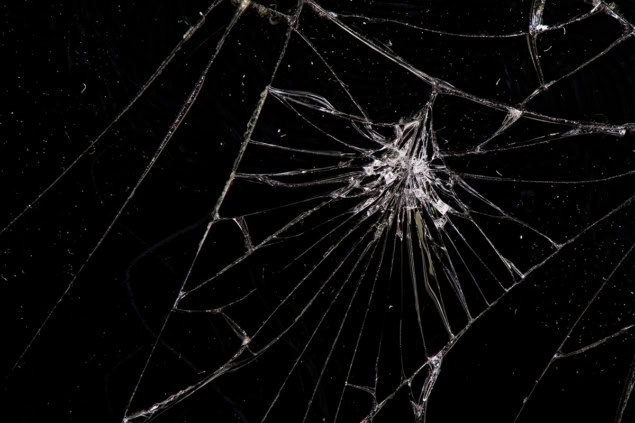
New research shows that phones could be strengthened by adding a layer of material to the screen that fluidized during an impact. In a paper published in PNAS, the team from the University of Edinburgh and Corning, a US-based materials company, developed a mathematical model of an object hitting a phone screen. Using modelling and experiments they identify the optimized fluid properties for this application. Their results show that fluids that become runnier during impact are most effective at protecting the screen.
Despite the development of toughened glass, a smashed phone screen is a commonplace annoyance. James Richards, a postdoc in Edinburgh who led the research, explains that the aim was to design a fluid-based alternative that would sit under the glass and absorb impacts.
The suspension of a car uses a piston moving through hydraulic fluid to absorb bumps in the road. The resistance of the fluid increases the faster the piston moves, which allows the system to adapt to large and small shocks.
In this project, instead of mechanical components, the screen would be protected by a layer of fluid, like a mattress sitting below the glass. To build a system that would adapt to different impacts, the researchers turned to a class of materials called non-Newtonian fluids, whose viscosity changes depending on the force applied. A mixture of cornflour and water is an example of a shear-thickening fluid because it becomes more viscous the harder it is hit. It is also possible to have shear-thinning fluids that become runnier under impact – an example of this is paint.
Soaking Kevlar vests in shear-thickening fluid can make them more resistant to projectiles because the fabric can absorb the impact whilst remaining flexible when worn. As a result, Richards and colleagues suspected that a shear-thickening fluid could also be used to protect phone screen glass.
When an object exerts a force on a screen, the fluid resists the deformation, but the force on the glass itself depends on how much the screen has deformed. This feedback loop makes it difficult to predict how a given fluid will respond, particularly if the fluid is non-Newtonian. “The challenge here is we didn’t know where we were in a design space,” says Richards “So we needed something much, much more general.”
The researchers wanted to perform an optimization that would test their theory that shear-thickening fluids are best at protecting the screen. This is challenging because the height of the bending screen varies continuously, so there are effectively an infinite number of variables to be optimized.
Simplified phone screen for design optimization
The team looked for a way to simplify the system whilst still capturing the essential physics. They identified that the problem would be a lot easier to solve if the screen was flat – meaning the height during impact would be the same everywhere. The quantity that determines whether the screen breaks would then just be the bending moment – the product of the diameter of the plate and the force on it.
The researchers argue that close to the impact, there will be some area of the plate that is effectively flat, with the size of this flat part becoming smaller the more the screen bends. By solving the equations of motion of the fluid under the plate, the researchers were able to reduce the problem of the flexible plate to a single flat plate whose diameter changes as it squeezes down.
With this simplified system, the team was able to factor in shear thickening or shear thinning fluid behaviour, allowing them to identify the fluid that minimized the bending moment. They were surprised to find that the optimal fluid was not shear-thickening but shear-thinning “It turns out our initial thoughts were entirely wrong” says Richards.
A tight squeeze causes an unexpected fluid response
They attribute this unexpected behaviour to the geometry of the system. During impact, the deformation of the screen squeezes the fluid through a smaller and smaller gap. It’s harder to push a shear-thickening fluid through a narrower space, so whilst it stops the impact, the glass experiences a large force. By contrast, if the fluid is shear-thinning, it will get easier to squeeze as the screen bends. This means the impact spreads out over a longer time, and provided the fluid never gets too runny, it is still possible to absorb the force whilst protecting the screen.
As proof of concept, the researchers tested transparent shear-thickening and shear-thinning fluids in an experiment that mimicked a phone screen. The fluid was sandwiched between a solid base and a sheet of glass, and the force on the glass was measured as a solid wedge pushed down on it. Their result confirms that the force on the glass increases more gradually during impact with the shear-thinning fluid, indicating that this class of fluids would be most effective as screen protectors.
The researchers say that one of their main motivations was to develop a shock absorber that could be used to build flexible phone screens. Their work establishes a framework to optimize the squeezing of non-Newtonian fluids, and they believe it could have applications such as in car windows or even to study how skin creams are applied.
- SEO Powered Content & PR Distribution. Get Amplified Today.
- PlatoData.Network Vertical Generative Ai. Empower Yourself. Access Here.
- PlatoAiStream. Web3 Intelligence. Knowledge Amplified. Access Here.
- PlatoESG. Carbon, CleanTech, Energy, Environment, Solar, Waste Management. Access Here.
- PlatoHealth. Biotech and Clinical Trials Intelligence. Access Here.
- Source: https://physicsworld.com/a/protecting-phone-screens-with-non-newtonian-fluids/



